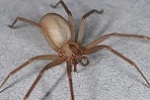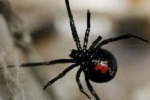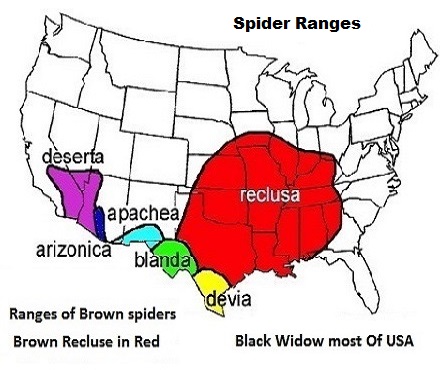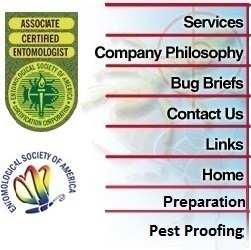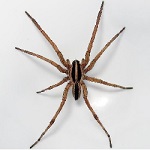|
Be Armed With Facts and not Fear When Thinking About Brown Recluse
excerpted from an article in Wired Magazine wired.com/2013/11/poor-misunderstood-brown-recluse
The brown recluse spider’s reputation vastly exceeds its reality.
It’s hard to think of a critter that inspires as much hyperbolic hysteria as the brown recluse spider. They’re pretty much universally hated. If you believe the tales, these small arachnids are biting people all day, every day, producing massive, stinking flesh-craters that require months of intensive care and perhaps a prosthetic appendage. Sometimes, it seems these spiders have nothing better to do than hunker down in dark corners throughout North America, waiting for tender human skin to present itself.
Though there are strands of truth in the hype, on the whole, it’s bunk.
It is true that some of the spider’s bites lead to necrotic skin lesions, but around 10 percent of them. The others aren’t that bad. The brown recluse (Loxosceles reclusa) only lives in a few states – basically, the warmer ones between the Rockies and the Appalachians. And they don’t really want to bite you. It’s actually not that easy for them.
The brown recluse reality is obscured by a number of factors, not the least of which involves gnarly internet photos. First, spiders in general are easy to fear, and misinformation about this species in particular abounds. Second, bite wound statistics are clouded by misreporting. Third, many other conditions can be misdiagnosed as brown recluse bites (like MRSA and fungal infections). Lastly, many other spiders (and insects) are mistaken for brown recluses.
“There is a really strong emotional and psychological aspect to the brown recluse,” said arachnologist Rick Vetter, now retired from the University of California, Riverside.
Inspired by the comments left on a story we did about the silk of a closely related recluse spider, the South American brown recluse, we decided to take a close look at our own continent’s most despised brown spider and the myths surrounding it.
First, a truth: Brown recluse bites can be bad. “They are a potentially dangerous spider,” said Vetter, who has spent decades studying the brown spiders. “They’re not harmless,” he says. “But the reputation they have garnered in this country is just amazing.”
Cases of Mistaken Identity
Much of Vetter’s work has involved verifying the identity of spiders purported to be brown recluses. In 2005, Vetter published the results of a nationwide appeal for spider specimens suspected to be L. reclusa: Please send me the spiders you think are brown recluses, and tell me where you’re from. He received 1,773 specimens, from 49 states. Less than 20 percent — 324 — were brown recluses. All but four of those came from states with endemic brown recluse populations.
“An initial goal of this study was to determine the spider characteristics that people were misconstruing as that of a brown recluse,” he wrote. “It became evident early in the study that all that was required was some brown [body] coloration and eight legs.”
‘People jump at the chance to hate spiders. It’s easier to vilify them than to adore their biology and natural history.’
Along the way, Vetter realized that authorities — such as poison control centers and physicians — aren’t much better at identifying the brown recluse. Even trained entomologists can get it wrong.
In 2009, Vetter took a close look at 38 arachnids incorrectly identified as recluses by 35 different authorities such as “physicians, entomologists, pest control operators – people you’d think would have reliable opinions,” Vetter said. Misidentifications included a solifuge (which isn’t even a spider), a grass spider pulled from a patient’s ear, and a desert grass spider that had bitten a young boy.
Part of the problem is that the brown recluse is small and brown and about the size of a quarter — like many other arachnids and insects. The best way to identify a brown recluse is to count its eyes: They’re among a few species of North American spiders that have six eyes instead of eight, arranged in three pairs of two.
But your typical spider-squisher isn’t going to get in a spider’s face with a magnifying glass and count its eyes. Some people may try to find the marking most commonly described as identifying a brown recluse: a violin shape on the spider’s head, oriented with the violin’s neck pointing toward the spider’s butt.
However, people are incredibly good at “seeing” violin markings on every portion of a spider’s body, Vetter says, which means this marking isn’t an especially helpful diagnostic.
“Arkansas and Missouri are the two states where they’re very, very dense,” Vetter said. Kansas, Oklahoma, the western portions of Tennessee and Kentucky, the southern parts of Indiana and Illinois, and the northeastern parts of Texas round out the recluse’s range.
Similar patterns exist in northwest states – Washington, Oregon, and Idaho – that are far outside the spider’s range, and other states on the spiders’ margins, like Indiana.
Cases of Mistaken Diagnosis
Vetter and other experts suspect that the brown recluse bite diagnosis is a popular catch-all for situations where the cause of a skin lesion can’t be easily identified. True, there are many things that can cause a nasty-looking flesh wound — but the brown recluse diagnosis carries an unlikely charisma. “If you get a bacterial infection, do you tell anyone about it? Of course not,” Vetter said. “But if you think you got a brown recluse bite, you tell everybody! You put it in your Christmas letter.”
Over the years, Vetter and his colleagues have compiled a list of about 40 things that can masquerade as recluse bites: bacterial infections, viral infections and fungal infections; poison oak and poison ivy; thermal burns, chemical burns; bad reactions to blood thinners; herpes.
“People want to believe [the culprit] is a spider species,” said entomologist Chris Buddle of McGill University, noting that it’s easier to blame a spider than something less familiar, like drug-resistant bacteria.
Most physicians don’t have a lot of experience discriminating between a recluse bite and something like necrotizing Staphylococcus. And even if a patient brings in a spider for identification, it’s unlikely the ER doctor has been trained to ID a brown recluse.
There are some ways in which brown recluse bites are different from many other wounds, however. A raised, reddish and wet wound is likely not a recluse bite, Vetter says. Recluse venom destroys small blood vessels and causes them to constrict, turning the area around the bite white, or purple, or blue. Fluids can’t flow to the area, and it sinks a little, and dries out.
In reality, just 10 percent of recluse bites require medical attention. The rest look like little pimples or mosquito bites or something else that doesn’t merit a trip to the emergency room, and they heal by themselves. But the reality about bite statistics doesn’t seem to matter. Even when faced with numbers and geographic distribution maps, people still cling tightly to their beliefs about the recluse and its arachnid malfeasance.
The Persistence of Myth
It is true that brown recluses like hiding in dark corners. They’re nocturnal and shy away from daylight and, sometimes, the outdoors. Hence the name. But they are not waiting in these dark corners to bite you. It’s possible to live with the spiders and not get bitten. Take the rather extreme example of a Kansas family that lived for six years in a house infested by 2,055 brown recluse spiders. Total bites: Zero.
In fact, the spiders’ fangs are too short and small to bite through pajamas or socks, and really only sturdy enough to puncture thin skin. Most bites occur when people roll over on the spiders in the night, or try to wear a shoe the spider has moved into. “Biting is a response to being crushed, but they’d much rather try and get away,” Vetter said.
‘If you get a bacterial infection, do you tell anyone about it? Of course not. But if you think you got a brown recluse bite, you tell everybody’ But the idea that something hazardous lurks in the dark, out of sight behind a toilet or inside a shoe, is a potent source of fear. The idea lodges in the psyche and is difficult to shake loose – especially when fed by popular media and peers. “The press has, by and large, painted spiders in a negative light,” Buddle said. “People jump at the chance to hate spiders. It’s easier to vilify them than to adore their biology and natural history.”
Things that are potentially harmful, move erratically, unpredictably, and sometimes quickly, are easy to fear. Spiders fall into this category, says psychologist Helena Purkis, who has studied arachnophobia and fear of snakes at the University of Queensland, Australia. And then, when people fear something, they expect it to be associated with bad things.
“The truth is, bad things happen to us all the time, and it’s completely random,” said entomologist Gwen Pearson, author of the WIRED Science Blog, Charismatic Minifauna. But being able to blame a nasty skin lesion on a spider is more satisfying than acknowledging that a necrotic crater has emerged on your arm for no identifiable reason, she says. Purkis described an experiment in which shocks were randomly paired with either pictures of flowers, or pictures of spiders. “People report that spiders, but not the flowers, were predictive of shocks – even when the presentations were completely random,” she said.
Searching for patterns in the noise is one of the ways human brains handle the overwhelming amount of stimuli in the world — but it also leads to misperceptions. Here, our fallibility is in our tendency to filter new information and remember facts more easily if they are consistent with our beliefs, Purkis says. This means that you could hear one bad story about a brown recluse bite and 10 stories about how the spiders aren’t so bad, and guess which one will stick?
|

